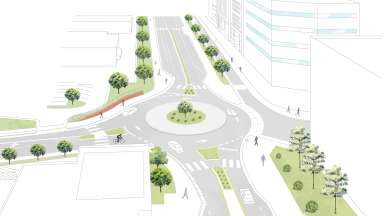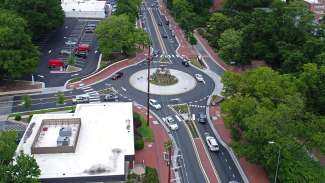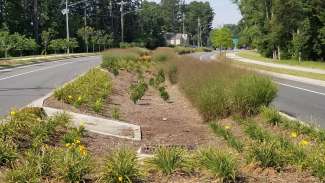Jump To:
The City strives to create streets that are great public spaces and sustainable transportation networks. Complete Streets accommodate all modes of transportation, allowing bicyclists, pedestrians, transit users, vehicles, as well as commercial and emergency vehicles to navigate City streets safely.
We listen to what residents have to say about the streets they live and travel on, by including community engagement during the design and construction phase of all our of streets and sidewalks projects.
Components
- Roundabouts
- Protected Intersections
- Medians
- Pedestrian refuge islands
- Multi-use paths
- Sidewalks with setbacks
- Transit infrastructure
- Bike lanes
- Technology
Environmental Benefits
The Complete Streets strategy supports environmental sustainability efforts by reducing greenhouse gas emissions and promoting greener practices.
Implementing alternative forms of transportation to street design creates safer and more accessible options for residents. Riding a bike in a bike lane, walking on a sidewalk, or using the bus instead of driving a car ultimately creates less greenhouse gas emissions.
Sustainable techniques are often used when constructing Complete Streets. By using warm-mix asphalt, fuel consumption decreases reducing the production of greenhouse gases. In addition, recycled materials, such as concrete, are used as base stone under roadway pavement. Did you know that asphalt is the world’s most recycled material?
Complete Streets also lower transportation costs over time through infrastructure such as roundabouts, which save energy when used instead of traffic lights.
When constructing Complete Streets, sustainable features like Green Stormwater Infrastructure (GSI) are often added to public streets. GSI promotes ecofriendly development and effective stormwater management to ensure that streets remain safe. Examples of GSI practices include:
- planting trees;
- creating bioretention basins, rain gardens, dry ponds, and wetlands;
- using permeable surfaces; and,
- adding plants that help manage stormwater runoff.
Finally, including more trees and green spaces when constructing Complete Streets helps decrease urban heat island effects and increase community aesthetical value.
Community Support
Equity is central to the Complete Streets strategy. Streets are designed to be accessible to everyone regardless of mode of travel, age, or physical ability. Emphasis is placed on meeting the needs of those who’ve experienced systematic underinvestment, including:
- Older adults,
- People with disabilities,
- Low-income neighborhoods, and
- Minority communities.
In addition to prioritizing accessibility, Complete Streets also prioritize safety. Through community-oriented development, the emphasis is taken away from commuters and automobiles.
Complete Streets also support communities through traffic-slowing measures, including raised crosswalks and road diets, and other measures, including bike lanes and level sidewalks.
We care about what residents have to say about the streets they live and travel on, and how they can best be served.
Do you have feedback for us? Share any comments or questions here.
Economic Development
The Complete Streets strategy increases connectivity, which leads to economic growth and development. Increased foot traffic on public streets helps local businesses to thrive.
Complete Streets also boost property values and employment levels in surrounding areas.
Complete streets are a step towards a better future in the ways they promote sustainable development that benefits the environment, neighborhoods, and local economy.
Read more about climate change and other City-wide sustainability initiatives!



